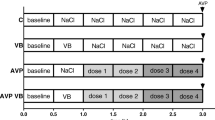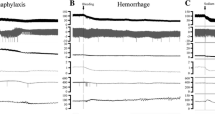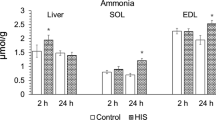Abstract
The aim of the study was to assess whether changes in gastric mucosal blood flow induced by acute normovolaemic anaemia influence the susceptibility of the gastric mucosa to ethanol-induced damage, and the relationship of these changes with nitric oxide biosynthesis. Acute normovolaemic anaemia, promoted by exchanging 3 ml of blood by a plasma expander, induced a significant increase in gastric mucosal blood flow measured by hydrogen gas clearance, without changes in arterial blood pressure. After intragastric 60% ethanol administration, gastric blood flow was still significantly higher in anaemic than in control rats, and this was associated with a lower macroscopic and microscopic gastric damage. Following ethanol administration, anaemic rats pretreated with an inhibitor of nitric oxide biosynthesis (l-NMMA, 50 mg/kg, i.v.) had a lower gastric blood flow and a higher macroscopic gastric damage than anaemic rats without pretreatment. Anaemic rats pretreated with vasopressin also had after ethanol administration a lower gastric blood flow and a higher macroscopic gastric damage. It is concluded that acute normovolaemic anaemia protects the gastric mucosa against damage induced by intragastric ethanol. The inhibition of nitric oxide biosynthesis reverts in part this protective effect, and this seems to be related with the capability of nitric oxide to increase gastric mucosal blood flow, since vasoconstriction by a nitric oxide-independent mechanism causes a similar effect.
Similar content being viewed by others
References
Anand IS, Chandrashekhar Y (1993) Reduced inhibition of endothelial-derived relaxing factor causes the hyperdynamic circulation in chronic severe anemia. Med Hypotheses 41:225–228
Bath PMW, Hasall DG, Gladwin AM, Palmer RMJ, Martin JF (1991) Nitric oxide and prostacyclin. Divergence of inhibitory effects on monocyte chemotaxis and adhesion to endothelium in vitro. Arterioscler Thromb 11:254–260
Boughton-Smith NK, Whittle BJR (1988) Inhibition by 16,16-dimethyl PGE2 of ethanol-induced gastric mucosal damage and leukotriene B4 and C4 formation. Prostglandins 35:945–957
Dintenfass L (1971) Blood-microrheology-viscosity factors in blood flow, ischemia, and thrombosis. Apple-Centruy-Crofts, New York
Fowler NO, Holmes JC (1975) Blood viscosity and cardiac output in acute experimental anemia. J Appl Physiol 39:453–456
Gaboury J, Woodman RC, Granger DN, Reinhardt P, Kubes P (1993) Nitric oxide prevents leukocyte adherence: role of superoxide. Am J Physiol 265:H862-H867
Guth PH, Paulsen G, Nagata H (1984) Histologic and microcirculatory changes in alcohol-induced gastric lesions in the rat: effect of prostaglandin cytoprotection. Gastroenterology 87:1083–1090
Jacobson ED (1992) Circulatory mechanisms of gastric mucosal damage and protection. Gastroenterology 102:1788–1800
Karmeli F, Eliakim R, Okon E, Rachmilewitz D (1991) Gastric mucosal damage by ethanol is mediated by substance P and prevented by ketotifen, a mast cell stabilizer. Gastroenterology 100:1206–1216
Kourembanas S, McQuillan LP, Leung GK, Faller DV (1993) Nitric oxide regulates the expression of vasoconstrictors and growth factors by vascular endothelium and both normoxia and hypoxia. J Clin Invest 92:99–104
Kravetz D, Arderiu MT, Bosch J, Piera C, Setoain J, Rodés J (1987) Increased plasma volume in two models of portal hypertension in the rat: cirrhosis of the liver and partial portal vein ligation. Rev Esp Fisiol 43:179–184
Kubes P, Suzuki M, Granger DN (1991) Nitric oxide: an endogenous modulator of leukocyte adhesion. Proc Natl Acad Sci USA 88:4651–4655
Kubes P (1992) Polymorphonuclear leukocyte-endothelium interactions: a role for pro-inflammatory and anti-inflammatory molecules. Can J Physiol 71:88–97
Lambrecht N, Trautmann M, Korojkiewicz R, Liszkay M, Peskar BM (1993) Role of eicosanoids, nitric oxide, and afferent neurones in antacid induced protection in the rat stomach. Gut 34:329–337
Leung FW, Guth PH, Scremin OU, Golanska E, Kauffman G Jr. (1984) Regional gastric mucosal blood flow measurements by hydrogen gas clearance in the anesthetized rat and rabbit. Gastroenterology 87:28–36
Leung FW, Itoh H, Hirabayashi K, Guth PH (1985) Role of blood flow in gastric and duodenal mucosal injury in the rat. Gastroenterology 88:281–289
Lippe IT, Holzer P (1992) Participation of endothelium-derived nitric oxide but not prostacyclin in the gastric mucosal hyperemia due to acid back-diffusion. Br J Pharmacol 105:708–714
MacNaughton WK, Cirino G, Wallace JL (1989) Endothelium-derived relaxing factor (nitric oxide) has protective actions in the stomach. Life Sci 45:1869–1876
Masuda E, Kawano S, Nagano K, Tsuji S, Ishigami Y, Tsujii M, Hayashi N, Fusamoto H, Kamada T (1992) Effect of intravascular ethanol on modulation of gastric mucosal integrity: possible role of endothelin-1. Am J Physiol 262:G785-G790
Murray JF, Escobar E, Rapaport E (1969) Effects of blood viscosity on hemodynamic response in acute normovolemic anemia. Am J Physiol 216:638–642
Panés J, Casadevall M, Piqué JM, Bosch J, Whittle BJR, Terés J (1992) Effects of acute normovolemic anemia on gastric mucosal blood flow in rats: role of nitric oxide. Gastroenterology 103:407–413
Pihan G, Majzoubi D, Haudenschild C, Trier JS, Szabo S (1986) Early microcirculatory stasis in acute gastric mucosal injury in the rat and prevention by 16,16-dimethyl prostaglandin E2 or sodium thiosulfate. Gastroenterology 91:1415–1426
Peskar BM, Lange K, Hoppe U, Peskar BA (1986) Ethanol stimulates formation of leukotriene C4 in rat gastric mucosa. Prostaglandins 31:283–293
Peskar BM, Responsek M, Müller KM, Peskar BA (1991) A role of nitric oxide in capsaicin-induced gastroprotection. Eur J Pharmacol 198:113–114
Piqué JM, Leung FW, Tan HW, Livingston E, Scremin OU, Guth PH (1988) Gastric mucosal blood flow response to stimulationa and inhibition of gastric acid secretion. Gastroenterology 95:642–650
Piqué JM, Whittle BJR, Esplugues JV (1989) The vasodilator role of endogenous nitric oxide in the rat gastric microcirculation. Eur J Pharmacol 174:293–296
Piqué JM, Esplugues JV, Whittle BJR (1992) Endogenous nitric oxide as a mediator of gastric mucosal vasodilatation during acid secretion. Gastroenterology 102:168–174
Pizcueta MP, Pique JM, Bosch J, Whittle BJR, Moncada S (1992) Effects of inhibiting nitric oxide biosynthesis on the systemic and splanchnic circulation of rats with portal hypertension. Br J Pharmacol 105:184–190
Quintero E, Guth PH (1992) Renal failure increases gastric mucosal blood flow and acid secretion in rats: role of endothelium-derived nitric oxide. Am J Physiol 263:G75-G80
Radomski MW, Palmer RMJ, Moncada S (1987) Endogenous nitric oxide inhibits human platelet adhesion to vascular endothelium. Lancet 11:1057–1058
Radomski MW, Palmer RMJ, Moncada S (1990) An L-arginine/nitric oxide pathway present in human platelets regulates aggregation. Proc Natl Acad Sci USA 87:5193–5197
Rooney MW, Hirsch LJ, Mathru M (1993) Hemodilution with oxyhemoglobin. Mechanism of oxygen delivery and its superaugmentation with a nitric oxide donor (sodium nitroprusside). Anesthesiology 79:60–72
Rosberg B, Wulff K (1979) Regional blood flow in normovolaemic and hypovolaemic haemodilution. An experimental study. Br J Anaesth 51:423–430
Szelenyi I, Brune K (1988) Possible role of oxygen free radicals in ethanol-induced gastric mucosal damage. Dig Dis Sci 33:865–871
Varat MA, Adolph RJ, Fowler NO (1972) The cardiovascular effects of anemia. Am Heart J 83:415–424
Wallace JL, Beck PL, Morris GP (1988) Is there a role for leukotrienes mediators of ethanol-induced gastric mucosal damage? Am J Physiol 254-G117-G123
Whittle BJR, Lopez-Belmonte J, Moncada S (1990) Regulation of gastric mucosal integrity by endogenous nitric oxide: interaction with prostanoids and sensory neuropeptides. Br J Pharmacol 99:607–611
Whittle BJR (1993) Neuronal and endothelium-derived mediators in the modulation of the gastric microcirculation: integrity in the balance. Br J Pharmacol 110:3–17
Yoneda M, Taché Y (1992) Central thyrotropin-releasing factor analog prevents ethanol-induced gastric damage through prostaglandins in rats. Gastroenterology 102:1568–1574
Yonei Y, Wayland H, Guth PH (1988) Role of arachidonic acid metabolites in ethanol vasoaction in rat gastric submucosa. Am J Physiol 55:G731-G737
Author information
Authors and Affiliations
Rights and permissions
About this article
Cite this article
Casadevall, M., Piqué, J.M., Cirera, I. et al. Acute normovolaemic anaemia prevents ethanol-induced gastric damage in rats through a blood flow related mechanism. Naunyn-Schmiedeberg's Arch Pharmacol 350, 569–574 (1994). https://doi.org/10.1007/BF00173028
Received:
Accepted:
Issue Date:
DOI: https://doi.org/10.1007/BF00173028




